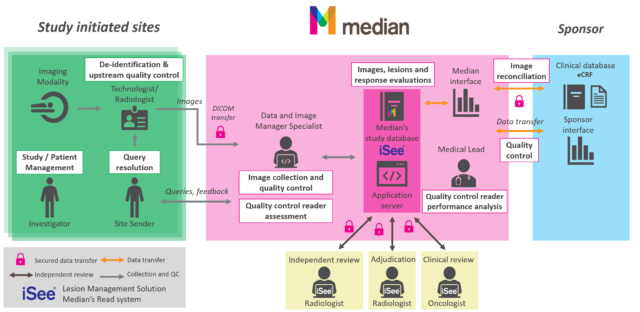Medical images management: how implementing proper processes and quality control can ensure maximum operational effectiveness and regulatory compliance
Between February 2018 and March 2019, ~44.9 million diagnostic imaging tests were performed in England[i]. That so many imaging tests were performed in a country with a population of ~66.8 million[ii] provides a small snapshot of the sheer volume of imaging data generated globally.
As medical imaging has advanced in the digital age, so has managing and sharing the generated data. In this post, we provide a brief overview of commonly used systems and discuss how implementing proper processes and quality control can ensure maximum operational effectiveness and regulatory compliance.
Download our: Medical Imaging in Oncology Review brochure here
DICOM, PACS, RIS, EHRs, HIS, VNAs
Accessibility and efficiency have been key drivers of innovation (as well as a multitude of acronyms!) in managing images, and several components have evolved. Standardization of medical image formats via DICOM (Digital Imaging and Communications in Medicine) in the 1990s fueled experimentations in medical image interpretation and analyses[iii]. The development of DICOM also played an important role in enabling connectivity for the PACS (Picture Archiving and Communication System) for data storage and the subsequent digitization of radiology departments[iii] (e.g., the development of the RIS (Radiological Information System), which complements a PACS).
Implementation of such processes facilitated healthcare providers to access medical images, together with EHRs (electronic health records) and HIS (Health Information System), of patients across departments and sites whenever and wherever needed. Consequently, more timely diagnoses and treatment decisions, reductions in duplicate/unnecessary imaging, and reduced administrative burden and costs were enabled.
However, if different PACS infrastructures are used in different departments, inter-operability problems may crop up, as an image captured and stored using one PACS might not open up in another PACS. Fragmentation and silos of datasets and operational inefficiencies can then ensue.
The adoption of VNAs (Vendor Neutral Archives) is one strategy that can help solve such issues. VNAs are bound by a general agreement on how DICOM images are stored and accessed via a networked interface. These non-proprietary standards therefore facilitate compatibility among different vendors[iv].
To summarize,
- DICOM is the international standard used to transmit, store and retrieve, process, print, and display medical imaging information.
- PACS and VNAs are technologies that provide economical and convenient systems for storing and accessing images from multiple modalities (e.g., CT scans, X-rays).
- A RIS is a networked software system for managing medical images and associated data (radiological reports), and is often used together with PACS/VNAs. A RIS is particularly useful for ensuring efficient radiology workflows, such as managing imaging orders and archives, patient lists, reports and billing information.
Implementing an image management system, however, forms just one part of the process; organizations must also be mindful of regulatory rules (e.g., HIPAA (Health Insurance Portability and Accountability Act of 1996) in the USA), quality control, risk management, and future proofing, among other aspects.
Other considerations of medical image management
Compliance: as noted in a commentary[v], although time-consuming, ensuring that your organization is compliant with regulatory rules and policies is essential, as the risks of non-compliance can be costly – in both financial and reputational terms.
Quality control and reduction of risk: advocating quality throughout the imaging process ensures that risks are also mitigated[vi]. For example, regularly maintaining imaging equipment, implementing stringent training, and standardizing the way images are captured and reported leads to high-quality data and promotes efficiencies.
Future proofing: as the volume of imaging data grows, balancing security with access in a cost-effective manner is a constant challenge. Cloud storage is a promising solution[vii] to many of the issues facing image management today. For example, a cloud-based service can reduce digital image storage expenses (due to lower hardware and staffing requirements) and provide data recovery in the event of a disaster (because it has automatically made a copy of the files and stored them in a separate system).
Data migration: as noted above, VNAs offer several advantages over PACSs; however, the challenges of migrating imaging data from a PACS to a VNA are not trivial[iv], and need to be considered when thinking about image management in an organization.
Maintaining operational continuity: strong communication, practical policies, and excellent teamwork are essential to ensure that any downtime (expected or unexpected) of an image management system is effectively controlled. A case study presented by a PACS administrative team manager[viii] provides an example of when lack of communication led to disastrous consequences (lost data and compromised business operations of multiple healthcare centers).
Conclusions
The pace of innovation in medical imaging technologies and capabilities (in particular Artificial Intelligence, as discussed in a previous blog) will also spur evolution in image management. Selecting the right imaging CRO for your clinical trial is therefore crucial.
The benefits of a high-quality image management system in a clinical trial are clear (see Figure 1), but the ultimate goal is optimized patient care, and this goal must be considered in deciding what system to use.
Benefits of a high-quality medical image management system in a clinical trial
- Seamless, end-to-end workflow
- Common imaging platform for investigator sites and independent review
- Automated reporting
- Centralized repository of all images and measurement data
- Live, on-site quality control and automate edit checks

Figure 1: Benefits of a high-quality medical image management system in a clinical trial
To know more about the fundamentals of medical imaging in oncology watch our Imaging 101 below
Sources:
[i] Diagnostic Imaging Dataset Annual Statistical Release 2019/20 https://www.england.nhs.uk/statistics/wp-content/uploads/sites/2/2020/10/Annual-Statistical-Release-2019-20-PDF-1.4MB.pdf
[ii] Overview of the UK population: January 2021 https://www.ons.gov.uk/peoplepopulationandcommunity/populationandmigration/populationestimates/articles/overviewoftheukpopulation/january2021
[iii] Kesner, A. et al. Medical Imaging Data in the Digital Innovation Age Med. Phys. 45 (4), e40–e52 (2018) https://aapm.onlinelibrary.wiley.com/doi/abs/10.1002/mp.12794
[iv] Pros and Cons of PACS, VNAs for Medical Image Data Storage https://hitinfrastructure.com/features/pros-and-cons-of-pacs-vnas-for-medical-image-data-storage
[v] Ritzer Ross, J. The Long Road to Compliance Radiol. Bus. 20 Nov 2017 http://www.radiologybusiness.com/topics/care-delivery/long-road-compliance
[vi] Craciun, H. et al. Risk Management in Radiology Departments World J. Radiol. 7 (6), 134–138 (2015) https://www.ncbi.nlm.nih.gov/pmc/articles/PMC4473307/
[vii] Finn, D. The Need for Improved Medical Image Storage 18 Jul 2011 https://www.itnonline.com/article/need-improved-medical-image-storage
[viii] Kyes, K. Avoiding Nightmare PACS Outages 16 Sep 2008 http://www.imagingbiz.com/topics/imaging-informatics/avoiding-nightmare-pacs-outages
